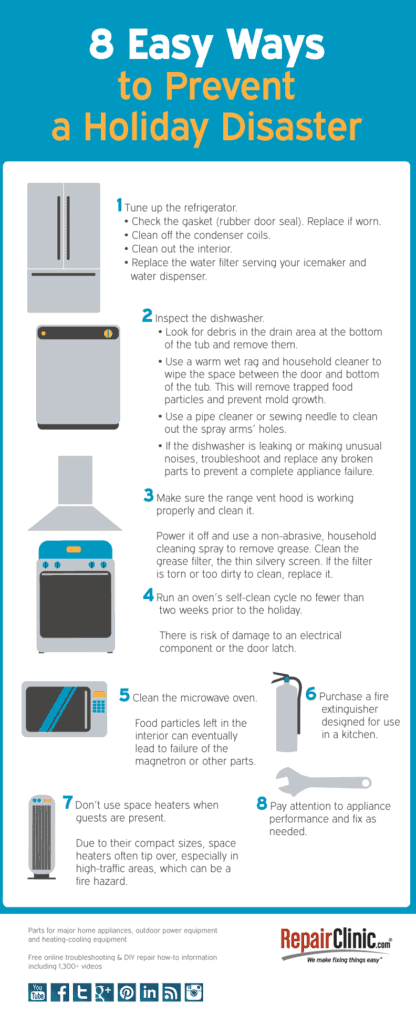To prevent a holiday disaster, ensure your appliances are in top shape: start with a refrigerator tune-up and check for any dishwasher issues. Run your oven’s self-clean cycle at least two weeks before the holiday, and clean your microwave to avoid part failures. Maintain a clean, functioning range vent hood, purchase a kitchen fire extinguisher, and avoid using space heaters with guests around. Finally, keep an eye on appliance performance and fix problems promptly using RepairClinic.com’s troubleshooting and repair help system.
1. Tune up the refrigerator.
“Refrigerators are often accessed more times during the holiday season than any other time of the year,” said Chris Hall, appliance repair technician and RepairClinic.com president and co-founder. “The more frequently doors are opened and closed, the harder the refrigerator must work. A few maintenance steps completed now will avoid a breakdown.”
- Check the gasket (rubber door seal), which helps keep warm air out. The gasket should be replaced if it is worn or torn. Gasket replacement is a simple, fast and inexpensive DIY job.
- Clean off the condenser coils. These are the large, radiator-like coils located at the back or beneath the unit. When dust and dirt cling to the coils, the refrigerator works harder to remove the heat. Dirty condenser coils lead to problems and costly repairs. Use a long-handled bristle brush and a vacuum to easily and efficiently clean off the coils. Refrigerator owner’s manuals provide specific instructions on how to efficiently do this.
- Clean out the interior: Use a rag and an all-purpose appliance cleaner to remove stains and sticky spills from shelves and walls.
- Replace the water filter serving your icemaker and water dispenser. These filters should be changed twice a year.
2. Inspect the dishwasher.
- Look for broken glass, fruit pits, toothpicks, bones and other debris in the drain area at the bottom of the tub and remove them.
- Use a warm wet rag and household cleaner to wipe the space between the door and bottom of the tub. This will remove trapped food particles and prevent mold growth.
- Use a pipe cleaner or sewing needle to clean out the spray arms’ holes.
- If the dishwasher is leaking or making unusual noises, troubleshoot and replace any broken parts to prevent a complete appliance failure.
3. Run an oven’s self-clean cycle no fewer than two weeks prior to the holiday.
“Due to the extreme temperatures associated with the self-cleaning function, there is risk of damage to an electrical component or the door latch,” said Hall. “If you’re cooking a holiday meal, you should run the self-cleaning feature at least a few weeks in advance to give yourself time to repair the range in time for holiday cooking.”
4. Clean the microwave oven.
Use a rag and warm, soapy water to remove spills from the interior. A heavy-duty degreaser will remove tough spills. Food particles left in the interior can eventually lead to failure of the magnetron or other parts. Glass trays may be cleaned in a dishwasher.
5. Make sure the range vent hood is working properly and clean it.
Whether the hood circulates air or vents it to the outside, it serves an important role in proper air flow. Power it off and use a non-abrasive, household cleaning spray to remove grease and dirt from the interior and exterior of the hood. Avoid spraying the cleaner directly onto the light bulb or light bulb socket.
Clean the grease filter, the thin silvery screen. It traps airborne oils and grease to keep them out of the blower and exhaust vent. Follow the owner’s manual for specific instructions related to this. Charcoal filters cannot be cleaned; they must be replaced when they lose effectiveness. If the filter is torn or too dirty to clean, replace it.
6. Purchase a fire extinguisher designed for kitchens.
Note that there are only one or two models that are approved for kitchen use. Know how to use the extinguisher and store it in an easily-accessible location.
7. Don’t use space heaters when guests are present.
Due to their compact sizes, space heaters often tip over, especially in high-traffic areas, which can be a fire hazard. Guests in your home are less likely to know where the heater is in the middle of the night.
8. Pay attention to appliance performance and fix as needed.
“If an appliance is making noises, leaking or taking longer to do its job, it’s a good idea to troubleshoot now and fix the issue before it causes a breakdown exactly when you need them most,” said Hall.
Use RepairClinic.com’s free online, advanced troubleshooting and repair help system to fix common problems associated with home appliances, outdoor power equipment and heating and cooling equipment. DIYers can enter a model number to choose from a list of common symptoms for that particular model, troubleshoot and watch expertly-produced videos to learn the most likely causes and conditions and purchase the correct part.

Comments are closed.